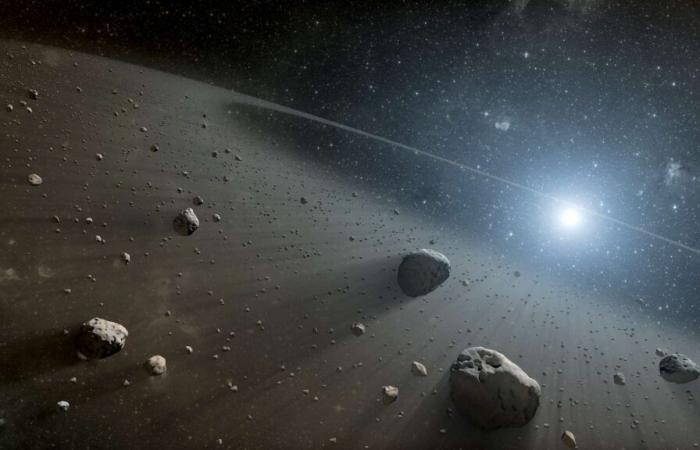Vega is the fifth brightest star in the sky and the brightest star in the constellation Lyra. It is only about 25 light years from the Solar System and has a mass more than twice that of the SoleilSoleilwhich means, according to the well-tested theory of stellar structure and evolution, that it will only remain on the planet for a billion years. main sequencemain sequence before becoming a red giantred giantthen to end his life in the form of woman blanchewoman blanche. Currently, it must be around 450 million years old.
Due to its proximity, it was therefore a target of choice for astrophysicistsastrophysicists and from the beginning of the 1980s, during the Iras mission observing in theinfraredinfrared from space, we detected a disk of mattermatter around it, similar to the one which, currently in the Solar System, is responsible for the zodiacal light.
Hubble was of course subsequently mobilized to observe it and more recently, the télescope spatial James-Webbtélescope spatial James-Webbthe JWST.
Simulations of the formation of planetary systems can be compared to the results of observations of this process by the James Webb Space Telescope. To obtain a fairly accurate French translation, click on the white rectangle at the bottom right. English subtitles should then appear. Then click on the nut to the right of the rectangle, then on “Subtitles” and finally on “Automatically translate”. Choose “French”. © NASA Goddard
A debris disk after gas dissipation from a protoplanetary disk
Vega has not long been in a phase with a protoplanetary diskprotoplanetary disk where planets are formed, but we can think that, just as in the case of the Solar System, its debris disk, a vestige of this protoplanetary disk and now devoid of the gazgaz that it contained, is formed of dust produced by continuous collisions between asteroidsasteroids in orbitorbit and the debris of cometscomets in evaporation, dust which ends up falling towards the central star.
But here too, as in the case of the Solar System, we observe in the debris disks around stars older than a hundred million years low density intervals dug by the planets in orbit accreting this dust. Thus, as explained in a press release from the NasaNasaFomalhaut, which is approximately the same distance, age and temperature as Vega, has three interlocking debris belts.
But surprisingly, we haven’t seen anything like this in the case of Vega for a while now! New observations with Hubble and JWST which led a team ofastronomersastronomers from the University of Arizona (in Tucson) to two articles on arXiv confirming this strangeness.
What are the differences between Vega and other stars?
Schuyler Wolff, from the University of Arizona team and lead author of the article presenting the results of the Hubble telescope, therefore declares in the NASA press release that “ Vega continues to be unusual. The architecture of the Vega system is markedly different from our own Solar System where giant planetsgiant planets as JupiterJupiter et SaturnSaturn prevent dust from spreading like it does with Vega ».
Just like the “shepherd satellites” of Saturn which gravitationally confine the dust of its rings, we have every reason to think that those of the Fomalhaut debris disk also undergo the same phenomenon due to the existence ofexoplanetsexoplanets although none have been positively identified to date. Which makes George Rieke, also a member of the University of Arizona research team, wonder: “ Given the similarity between the Vega starsVega stars and from Fomalhaut, why does Fomalhaut seem to have been able to form planets and not Vega? ».
Schuyler Wolff is not to be outdone: “ What’s the difference? Is it the circumstellar environment, or the star itself, which created this difference? What is intriguing is that the same physiquephysique is at work in both cases ».
« Hubble and Webb’s observations provide so much detail that they tell us something completely new about the Vega system that no one knew before », adds Rieke while her colleague Others’Others’ Gáspár declares, for his part, that ” between the Hubble and Webb telescopes, we have a very clear view of Vega. It’s a mysterious system because it’s different from other circumstellar disks we’ve observed. Vega’s disc is smooth, ridiculously smooth ».
« It makes us rethink the scope and variety of exoplanet systems “, concludes Kate Su, of the University of Arizona, lead author of the article presenting Webb’s findings.
The formation of the Solar System explained by Sean Raymond, astrophysicist at the Bordeaux Astrophysics Laboratory. A video of the AstrobioEducation educational course. © French Society of Exobiology
Did you know?
L’Infrared Astronomical Satellite (Iras) was the first space telescope to study the entire sky in infrared light. It was placed by NASA in a sun-synchronous orbit on January 25, 1983, operating for ten months until the liquid helium used to cool its instruments ran out. Iras was a technical and scientific precursor to future iconic infrared space missions, including the Spitzer, James-Webb, and Herschel space telescopes. Iras detected around 350,000 infrared sources and made a number of unexpected discoveries, including evidence of dust grains around the stars Vega and Beta Pictoris, which already strongly suggested the existence of planetary systems around other stars.
So, in the case of Vega, a puzzling excess of infrared light from hot dust was detected by Iras. It was interpreted as a shell or disk of dust extending twice Pluto’s orbital radius from the star, providing the first evidence of the existence of material orbiting a star.
Scientists began seriously modeling the formation of protoplanetary disks and planets after World War II. On this subject we can cite the work during the 1950s and 1960s of pioneers such as Viktor Safronov, Alastair Cameron and Harold Urey, inspired by a hypothesis which was first put forward by Immanuel Kant in 1775. The progress of computers has allowed us to explore in more detail the models proposed since then.






